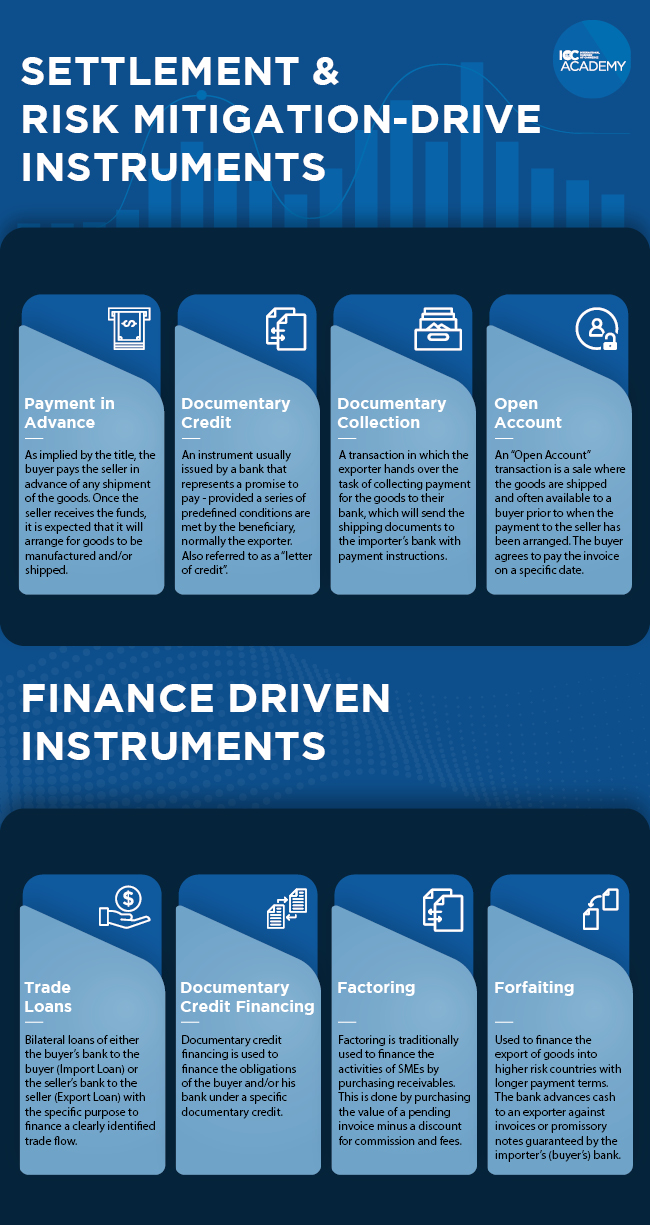Trade finance is the term used to describe the settlement arrangements available to buyers (importers) and sellers (exporters) that are used to mitigate risks and ensure the terms and conditions of an underlying commercial contract are met. I.e. the exporter gets paid and the importer receives the goods or services, both with minimal risk.
According to the World Trade Organization, 80 to 90 per cent of world trade relies on trade finance in some capacity.
Why does trade finance exist?
Although global trade forms an integral part of the global economy, there are numerous risks involved in conducting business across borders. The key to fulfilling a successful trade transaction is to understand and mitigate these associated risks. Not all risks may be applicable to an individual trade transaction but it is important to have an awareness of all the involved issues.
For example, you will likely encounter sales contracts with credit terms which allow the buyer of the goods to only pay the seller after the delivery of the goods.

These types of credit terms can result in a drain on the seller’s working capital to cover the period of research, manufacturing, shipment, and customs clearance. This is an illustration of where the banks can step in to help both parties.
How does trade finance work?
A typical trade finance transaction will include the buyer (importer), the seller (exporter) and the banks of the buyer and seller.
The buyer agrees to acquire ownership (of goods), or benefit or usage (of services) under a contract of sale. The seller agrees to make a sale to an actual or potential buyer for products or services, under a contract of sale. Banks can provide the funding and liquidity arrangements to help settle the contract of sale. Allowing accessible financing along the entire physical supply chain ensures exponential benefits to all entities involved in a trade transaction.
The ‘risk ladder’ is an important tool to help buyers and sellers determine the most appropriate form of settlement depending upon client relationship, location of the parties, goods or services that are involved, movement of funds and documents, and the options for settlement and financing.
It is important to note that as relationships evolve between both parties, more relaxed terms of settlement may be agreed. In order of preference for the seller (the opposite will apply for the buyer): Payment in Advance, Documentary Credit, Documentary Collection, Open Account.
What are the different types of trade finance solutions?
Today, a broad set of trade finance solutions are available to corporations around the globe, they are all directed to satisfy needs of risk mitigation, settlement, information, and finance.
The "traditional" trade finance solution set can be split into two main categories:
- Settlement & risk mitigation-driven instruments: these provide payment assurance and/or trigger points for the payment itself. In short, these instruments satisfy the settlement and risk-mitigation needs of a company.
- Finance-driven instruments: These instruments primarily satisfy the financial needs of a company but also provide some risk-mitigation coverage.
In the graphic below we have given some examples of the different solutions for each category - please note this list is not all-encompassing.

Benefits of trade finance
Here are some of the key benefits to the main parties involved in a trade finance transaction.
Buyers (Importers) and Sellers (Exporters):
- Allows another party to assume the relevant risks.
- Secures more accessible risk mitigation and improved working capital flows.
- Ensures automated processes.
- Facilitates lower transaction cost enabling reduced transaction pricing.
Banks:
- Enhances client relationships via provision of specific trade financing tools and solutions.
- Increases understanding of client businesses.
- Enables enhanced data integration and advanced financing solutions.
- Ensures reduced processing costs and facilitates shorter transaction completion times.
How has trade finance adapted to COVID-19?
Banks/market
As stated in the ICC Banking Commission paper on Trade financing and COVID-19, the COVID-19 crisis risks further exacerbating longstanding constraints in the trade finance market in a number of strategically important segments from an economic development perspective.
It has also uniquely exposed an additional vulnerability in the provision of bank- intermediated trade financing: specifically, its reliance on paper-based processes. Due to the necessary public health measures taken in response to the pandemic (such as “social distancing” or teleworking), banks faced growing difficulties processing paper-based transactions which, by their very nature, require significant levels of in-person “back office” staffing.
Commercial banks have been quick to respond to the early impacts of the crisis, working to actively support clients and adopting novel working practices to limit disruptions to the processing of transactions.
The International Chamber of Commerce
The ICC Banking Commission has also issued guidance to help banks manage COVID-19 related disruptions by adapting the application of its widely used rules for key trade finance products.
This paper collates common practices undertaken by global banks in the COVID-19 emergency situation and shares some guidance.
ICC has numerous tools to help, and the ICC Digital Trade Roadmap has been designed to help with advocacy with regulators, governments and employers.
Additionally, entities involved in global trade will find it useful to utilise both the eUCP Version 2.0 and the eURC Version 1.0 as operating models whilst configuring internal processes for greater use of these rules.
Further Learning
If you want to enhance your understanding of trade finance further, we recommend our online Global Trade Certificate (GTC) programme.
Global Trade Certificate (GTC):
The GTC is our introductory trade finance certification programme. It will give you a thorough and broad understanding of the various trade finance techniques and settlement methods available.
GTC Students get access to 14 individual courses covering documentary credits, guarantees, standby letters of credit, supply chain finance and much more. Once you have completed nine of the courses you will be eligible to take the final exam. If you pass you will receive an internationally recognized ICC Academy certificate. Use it to signal your expertise to clients and colleagues. Once you have passed the GTC you can take more advanced qualifications such as the Certified Trade Finance Professional (CTFP).
Contributors to this article:
With thanks to David Meynell for helping us write this article. David is a Senior Technical Advisor to the ICC Banking Commission and also runs his own trade finance training company. David has previously written comprehensive posts for us on documentary credits, including a comprehensive guide to the different types available.
David Meynell
Senior Technical Advisor, ICC Banking Commission
Co-owner www.tradefinance.training
Managing Director TradeLC Advisory
Tel: +44(0)7801 922359
Email: davidmeynell@aol.com

